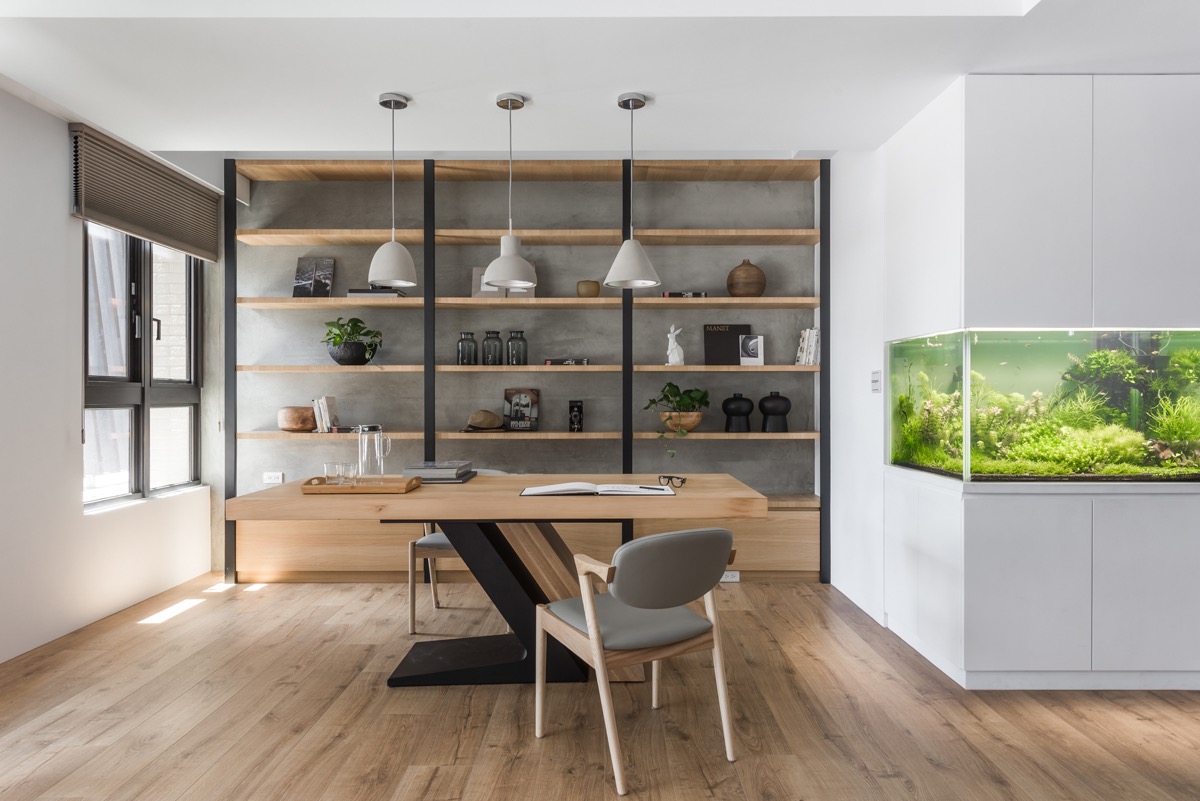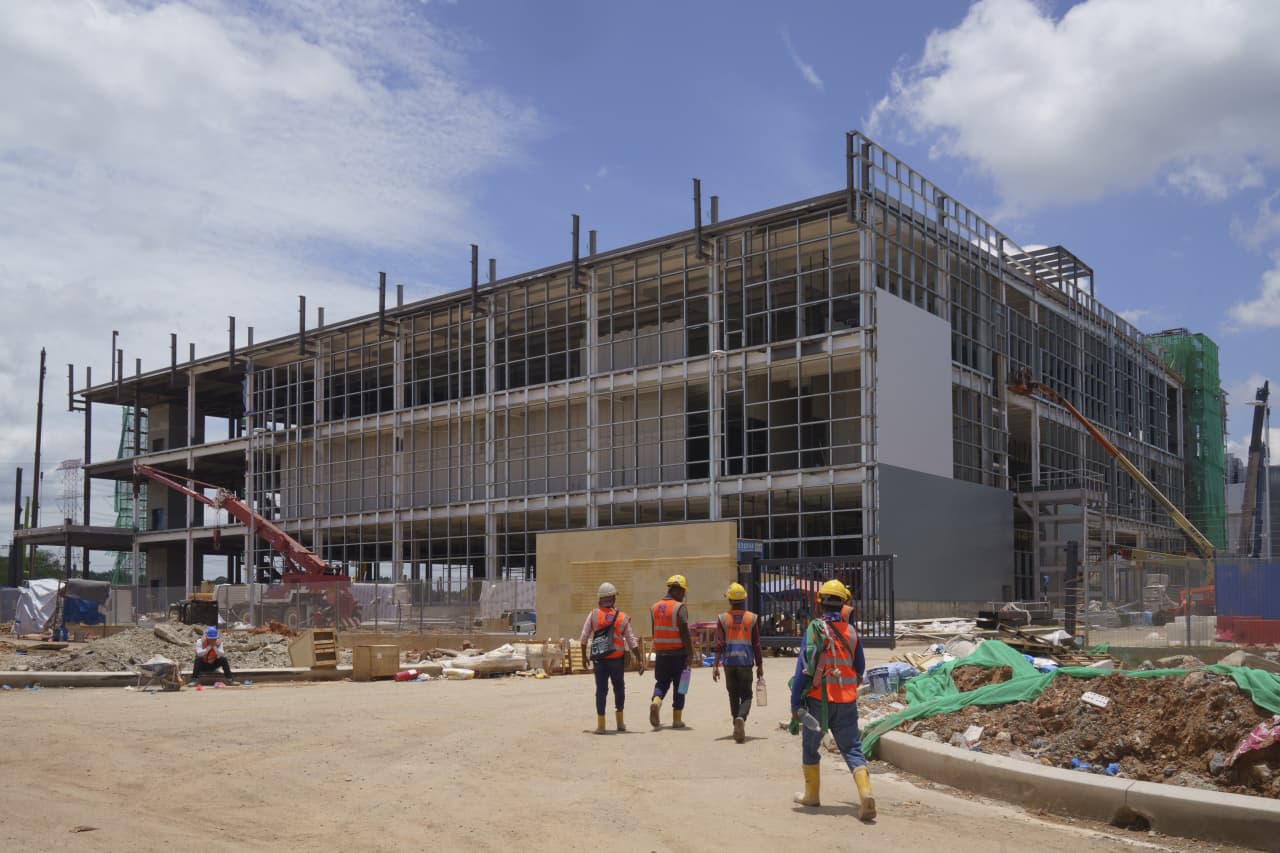How To Avoid The 5 Worst Home Office Design Mistakes
We asked designers and architects for the inspiration-crushing gaffes they see in residential workspaces, and what to do instead. Plus: the most egregious home-office setups they’ve witnessed.
FOR A YEAR now we’ve all been getting copious advice on how to make our remote workspaces worthy of our toil. Why then, incredulous designers want to know, are they still seeing people’s unmade beds during video calls?
“Professionals should exude professionalism,” said New York designer Vicente Wolf, who’s seen home offices cheapened by obviously plastic floral arrangements. “Keep the space clean and tidy. Straighten pictures, edit your bookcase. Take the time to see your background as it is conveyed by your computer’s eye.”
Here, interiors pros share five other home office blunders they’ve observed, and what to do instead.
Dead-end Desks
The quickest way to make your office feel like a college dorm room? Shove an undersized desk against a windowless wall, warned Dallas architect Eddie Maestri. “Nothing looks more sad and depressing.”
Instead: “What you see affects your mood and increases your work performance,” said Mr Maestri. If a real vista isn’t available, he positions the desk so its occupant has an expansive view of the room.
Cable Mayhem
Leave webs to the spiders. “I hate when tangled cords dangle from the desk in plain sight,” said Dallas designer Traci Connell.
Instead: If you have scope to place your desk against the back of a sofa or love seat, suggests Mark Lavender, an interior designer in Winnetka, Ill., “cords can then run behind the sofa, and the desk lamp pulls double duty as a sofa light.” Ms Connell channels cords through grommet holes she has drilled into desktops. Adapting the same idea, New York architect Eric J. Smith outfits a drawer or cabinet with a power strip and cables for an out-of-site charging station. Mr Maestri suggests this hack: “Connect all your cords to one power strip, then place the power strip and additional cord lengths in a small wastebasket under your desk.”
Workplace Drift
If you can’t shut the door on a dedicated workplace come day’s end, your “office” confronts you until bedtime, with files and monitors leering at you while you try to relax. Uncontained professional detritus compromises the life part of the life-work balance.
Instead: “It’s important to retain the other functions of the room,” said Mr Smith. Los Angeles designer Anne Carr’s stern advice: Order a cabinet, “preferably one with doors that close.” A bookcase with bins or baskets, she noted, can also hide essential but essentially ugly gear. Another option: a small, wheeled filing cabinet that can be pulled out during the day for extra desk space and tucked under a simple desk after hours, said Jerry Caldari of New York’s Bromley Caldari Architects. An inherently beautiful desk itself can pass for a civilized member of the family. Veronica Mishaan, a designer with offices in Bogotá, Colombia, and New York, chooses secretaries, whose surfaces fold up, or small, delicately curved desks. Both blend into a room without screaming “workspace,” she said.
Aping the Actual Office
“You don’t need an ordinary black faux-leather chair—or one that looks like your kid’s gaming chair—pulled up to a clunky wooden desk to make you feel that you’re ‘working’ from home,” said Spencer Bass, creative director for office furniture retailer Label 180.
Instead: While the ideal work chair is still ergonomic, you can de-corporate the rest of your space. Chairish co-founder Anna Brockway suggests swapping utilitarian task lamps for ceramic varieties with contrasting colour shades—a magnolia-green lamp and cornflower-blue shade, for example. Hang artwork that inspires you, “and don’t forget about desktop accessories like vases with fresh flowers and beautiful vessels to hold your paper clips,” she said.
Permeable Portals
Pocket doors and sliding barn doors leave gaps that let the voices of remote-learners and WFH mates bounce right through.
Instead: Get a real door! Swinging solid ones are Brooklyn designer Adam Meshberg’s first choice, “not only for your privacy, but for the rest of the [household which] likely doesn’t care much about your conversations.” If natural light is a concern, he said, frosted glass doors let sunshine through but not the gaze of curious kids. Mr Meshberg also finds virtue in hardware that locks to let the “Zoom calls we’re all constantly on” unfold uninterrupted.
DESK SCARES / The worst WFH setups pros have seen
“A home office situated inside the walk-in closet…with the clothes hanging all over the work area.” —Vicente Wolf, designer, New York City
“I designed a home for a family that bought two used cubicles and put them in their formal living room. It was quite the negotiation to get them to sell the desks and start fresh.” —Kiel Wuellner, vice president of design at Vesta
“I had a client who was a big-game hunter and wanted me to make the legs of one of his safari animals into desk legs. I had to take a hard pass on this job.” —Chris Goddard, designer, Springdale, Ark.
“A urinal in the room! Can you imagine?” —Elizabeth Krueger, designer, Chicago
“An office that was covered floor to ceiling in white boards with words and tasks listed in tiny handwriting everywhere. It’s instant overwhelm.” —Christina Kim, designer, Manasquan, N.J.
 Copyright 2020, Dow Jones & Company, Inc. All Rights Reserved Worldwide. LEARN MORE
Copyright 2020, Dow Jones & Company, Inc. All Rights Reserved Worldwide. LEARN MORE
This stylish family home combines a classic palette and finishes with a flexible floorplan
Just 55 minutes from Sydney, make this your creative getaway located in the majestic Hawkesbury region.
The remote northern island wants more visitors: ‘It’s the rumbling before the herd is coming,’ one hotel manager says
As European hot spots become overcrowded , travellers are digging deeper to find those less-populated but still brag-worthy locations. Greenland, moving up the list, is bracing for its new popularity.
Aria Varasteh has been to 69 countries, including almost all of Europe. He now wants to visit more remote places and avoid spots swarmed by tourists—starting with Greenland.
“I want a taste of something different,” said the 34-year-old founder of a consulting firm serving clients in the Washington, D.C., area.
He originally planned to go to Nuuk, the island’s capital, this fall via out-of-the-way connections, given there wasn’t a nonstop flight from the U.S. But this month United Airlines announced a nonstop, four-hour flight from Newark Liberty International Airport in New Jersey to Nuuk. The route, beginning next summer, is a first for a U.S. airline, according to Greenland tourism officials.
It marks a significant milestone in the territory’s push for more international visitors. Airlines ran flights with a combined 55,000 seats to Greenland from April to August of this year, says Jens Lauridsen, chief executive officer of Greenland Airports. That figure will nearly double next year in the same period, he says, to about 105,000 seats.
The possible coming surge of travellers also presents a challenge for a vast island of 56,000 people as nearby destinations from Iceland to Spain grapple with the consequences of over tourism.
Greenlandic officials say they have watched closely and made deliberate efforts to slowly scale up their plans for visitors. An investment north of $700 million will yield three new airports, the first of which will open next month in Nuuk.
“It’s the rumbling before the herd is coming,” says Mads Mitchell, general manager of Hotel Nordbo, a 67-room property in Nuuk. The owner of his property is considering adding 50 more rooms to meet demand in the coming years.
Mitchell has recently met with travel agents from Brooklyn, N.Y., South Korea and China. He says he welcomes new tourists, but fears tourism will grow too quickly.
“Like in Barcelona, you get tired of tourists, because it’s too much and it pushes out the locals, that is my concern,” he says. “So it’s finding this balance of like showing the love for Greenland and showing the amazing possibilities, but not getting too much too fast.”
Greenland’s buildup
Greenland is an autonomous territory of Denmark more than three times the size of Texas. Tourists travel by boat or small aircraft when venturing to different regions—virtually no roads connect towns or settlements.
Greenland decided to invest in airport infrastructure in 2018 as part of an effort to expand tourism and its role in the economy, which is largely dependent on fishing and subsidies from Denmark. In the coming years, airports in Ilulissat and Qaqortoq, areas known for their scenic fjords, will open.
One narrow-body flight, like what United plans, will generate $200,000 in spending, including hotels, tours and other purchases, Lauridsen says. He calls it a “very significant economic impact.”
In 2023, foreign tourism brought a total of over $270 million to Greenland’s economy, according to Visit Greenland, the tourism and marketing arm owned by the government. Expedition cruises visit the territory, as well as adventure tours.
United will fly twice weekly to Nuuk on its 737 MAX 8, which will seat 166 passengers, starting in June .
“We look for new destinations, we look for hot destinations and destinations, most importantly, we can make money in,” Andrew Nocella , United’s chief commercial officer, said in the company’s earnings call earlier in October.
On the runway
Greenland has looked to nearby Iceland to learn from its experiences with tourism, says Air Greenland Group CEO Jacob Nitter Sørensen. Tiny Iceland still has about seven times the population of its western neighbour.
Nuuk’s new airport will become the new trans-Atlantic hub for Air Greenland, the national carrier. It flies to 14 airports and 46 heliports across the territory.
“Of course, there are discussions about avoiding mass tourism. But right now, I think there is a natural limit in terms of the receiving capacity,” Nitter says.
Air Greenland doesn’t fly nonstop from the U.S. because there isn’t currently enough space to accommodate all travellers in hotels, Nitter says. Air Greenland is building a new hotel in Ilulissat to increase capacity when the airport opens.
Nuuk has just over 550 hotel rooms, according to government documents. A tourism analysis published by Visit Greenland predicts there could be a shortage in rooms beginning in 2027. Most U.S. visitors will stay four to 10 nights, according to traveler sentiment data from Visit Greenland.
As travel picks up, visitors should expect more changes. Officials expect to pass new legislation that would further regulate tourism in time for the 2025 season. Rules on zoning would give local communities the power to limit tourism when needed, says Naaja H. Nathanielsen, minister for business, trade, raw materials, justice and gender equality.
Areas in a so-called red zone would ban tour operators. In northern Greenland, traditional hunting takes place at certain times of year and requires silence, which doesn’t work with cruise ships coming in, Nathanielsen says.
Part of the proposal would require tour operators to be locally based to ensure they pay taxes in Greenland and so that tourists receive local knowledge of the culture. Nathanielsen also plans to introduce a proposal to govern cruise tourism to ensure more travelers stay and eat locally, rather than just walk around for a few hours and grab a cup of coffee, she says.
Public sentiment has remained in favour of tourism as visitor arrivals have increased, Nathanielsen says.
—Roshan Fernandez contributed to this article.
This stylish family home combines a classic palette and finishes with a flexible floorplan
Just 55 minutes from Sydney, make this your creative getaway located in the majestic Hawkesbury region.






















